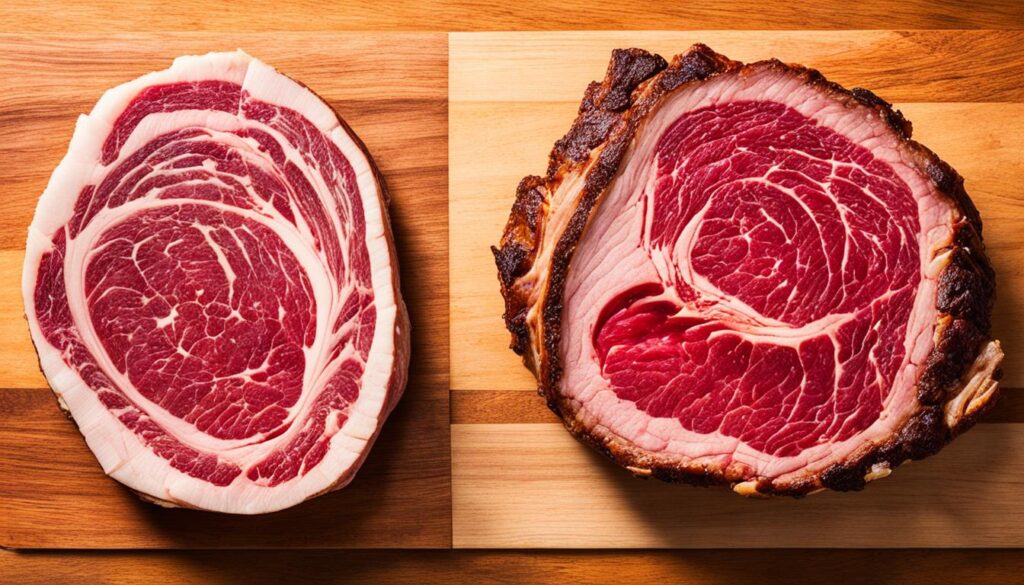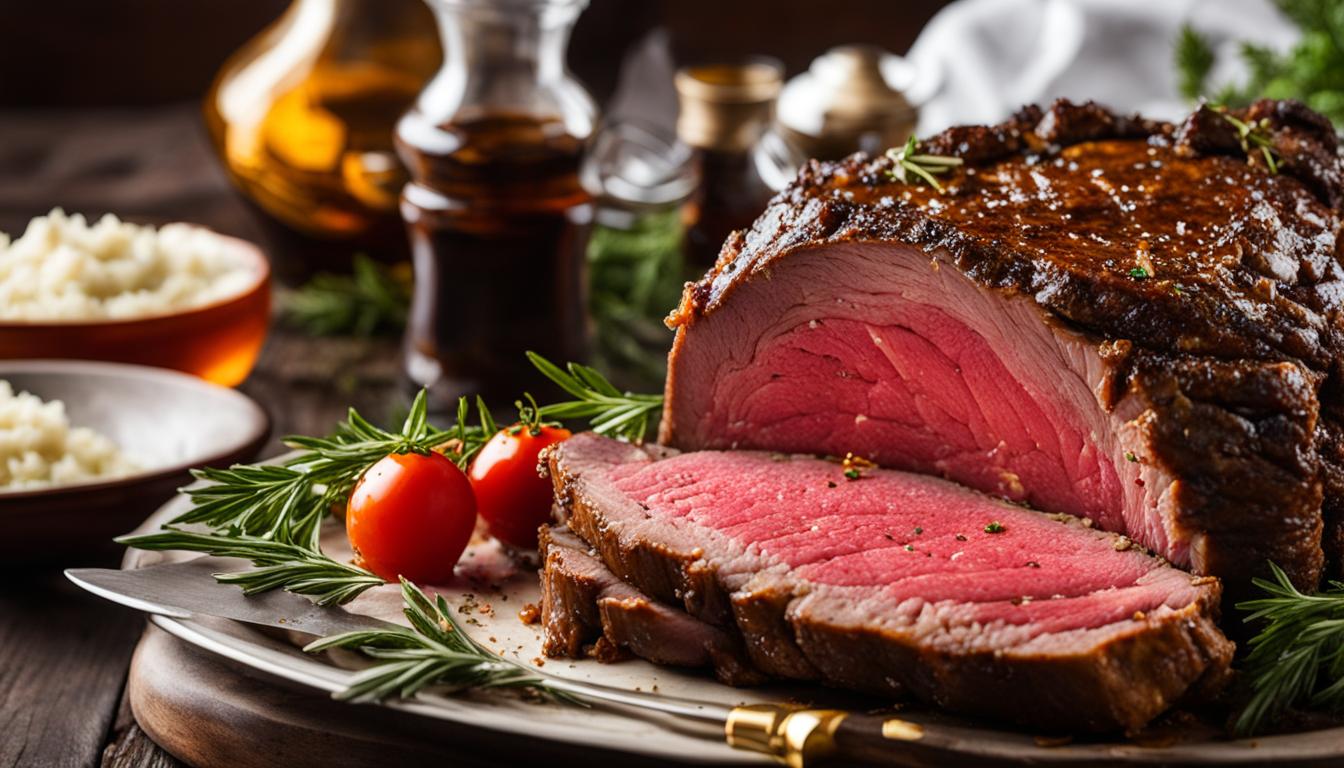Christmas dinner is a special time to gather with loved ones and indulge in delicious, festive dishes. And what better centerpiece for your holiday meal than a perfectly cooked prime rib? But the thought of cooking such a prime cut of beef might seem intimidating. Well, fear not! We have the ultimate guide to help you make the perfect prime rib for your Christmas dinner.
Making prime rib doesn’t have to be a challenge. With our step-by-step instructions and expert tips, you’ll be able to achieve a juicy, tender, and flavorful prime rib that will have your guests raving.
So, how do you ensure that your prime rib turns out just right? The secret lies in using a meat thermometer. By monitoring the internal temperature of the meat, you can cook it to your desired level of doneness, whether it’s rare, medium-rare, or well-done.
But that’s not all. The cooking time and temperature are also crucial factors in achieving that perfect prime rib. We’ll share with you the ideal cooking time and temperature for different levels of doneness, so you can confidently cook your prime rib to perfection.
And once you’ve mastered the art of cooking prime rib, you might find yourself wondering about the difference between prime rib and ribeye. We’ll clear up any confusion and give you the lowdown on these two mouthwatering cuts of beef.
But what if you have leftovers? Don’t worry, we have plenty of tasty ideas for using up your leftover prime rib. From sandwiches to stews, we’ll show you how to transform those extra slices into delicious new meals.
Finally, as Christmas dinner is a time to truly celebrate, we’ll also provide you with tips and ideas to create a festive and unforgettable holiday feast. Elevate your Christmas dinner with creative side dishes and additional holiday recipes that will complement your perfect prime rib.
So, are you ready to wow your guests with the perfect prime rib for Christmas dinner? Let’s dive in and show you just how it’s done.
The Secret to Making Perfect Prime Rib
When it comes to making a mouthwatering prime rib, there is a secret ingredient that guarantees success every time: a meat thermometer.
A meat thermometer is an essential tool for ensuring that your prime rib is cooked to perfection, reaching your desired level of doneness. By monitoring the internal temperature of the meat, you can avoid the guesswork and achieve consistently juicy and tender results.
Before cooking your prime rib, it’s crucial to let the meat come to room temperature. This allows for more even cooking throughout the roast. Simply take the prime rib out of the refrigerator and let it sit at room temperature for about an hour, allowing the meat to relax and its natural flavors to shine.
When it comes to cooking techniques, a general rule for prime rib is to start with a high temperature and then reduce it. Begin by preheating your oven to a high temperature, usually around 450°F (230°C). This initial blast of heat will help to sear the outside of the meat, creating a delicious crust. After about 15-20 minutes, reduce the temperature to around 325°F (163°C) and continue cooking until the desired internal temperature is reached.
Remember to use the meat thermometer to check the internal temperature of the prime rib. Depending on your desired level of doneness, the meat’s internal temperature can vary. For a rare prime rib, aim for an internal temperature of 120-125°F (49-52°C). If you prefer medium-rare, aim for 130-135°F (54-57°C). Keep in mind that the temperature will continue to rise slightly after the meat is removed from the oven.
By following these simple instructions and cooking techniques, you’ll be able to achieve a perfectly cooked prime rib every time. So, grab your meat thermometer, prepare your ingredients, and get ready to impress your guests with an unforgettable prime rib feast.
Cooking Time and Temperature for Prime Rib
When it comes to cooking the perfect prime rib, getting the cooking time and temperature right is crucial. The cooking time will vary depending on the size of the roast and your desired level of doneness. To achieve the best results, we recommend following these guidelines:
- Preheat your oven to a high temperature of around 500°F. This high heat will help sear the outside of the prime rib and lock in the juices.
- Place the prime rib in a roasting pan and insert a meat thermometer into the thickest part of the roast, being careful not to touch any bones. This will allow you to monitor the internal temperature.
- Roast the prime rib at the high temperature for about 15 minutes to sear the outside.
- Reduce the oven temperature to around 300°F and continue cooking the prime rib for the remaining time. The total cooking time will depend on the size of the roast, but as a general guideline, you can calculate approximately 15 minutes of cooking time per pound of meat.
- While cooking, monitor the internal temperature of the prime rib using the meat thermometer. For a rare to medium-rare prime rib, the internal temperature should be around 120 to 125 degrees.
Remember, it’s crucial not to overcook the prime rib to prevent it from becoming dry and tough. By following these cooking time and temperature guidelines and monitoring the internal temperature with a meat thermometer, you’ll be able to achieve a perfectly cooked prime rib that is juicy, tender, and full of flavor.
Difference Between Prime Rib and Ribeye
When it comes to prime rib and ribeye, there are subtle differences to take note of. Prime rib refers to a whole rib roast that is cooked as a whole piece, whereas ribeye is a portion of the prime rib that is cut into individual steaks before cooking.
Prime rib is known for its rich marbling and tender texture, making it an excellent choice for a special occasion or holiday feast. The roast is typically slow-cooked to allow the marbling to melt into the meat, resulting in a juicy and flavorful centerpiece for any meal.
Ribeye steaks, on the other hand, are cut from the prime rib roast and offer a more individualized dining experience. Each steak is boneless, well-marbled, and packed with intense beef flavor. Ribeye steaks are often grilled or pan-seared to create a delicious crust while retaining the tenderness inside.

Although prime rib and ribeye come from the same cut of beef, the preparation and cooking techniques vary slightly. Prime rib is cooked as a whole roast, allowing for a slow and even cooking process. On the other hand, ribeye steaks are cooked individually, allowing for faster cooking times and customization depending on each diner’s preferred level of doneness.
Whether you choose to serve a beautiful prime rib roast or juicy ribeye steaks, both cuts offer incredible flavor and tenderness. Understanding the distinction between prime rib and ribeye can help you select the perfect cut for your next meal.
What to Do with Leftover Prime Rib
If you have leftover prime rib, there are many delicious ways to make the most of it. Don’t let those savory flavors go to waste! Here are some creative ideas to transform your leftover prime rib into new and exciting dishes:
- Prime Rib Sandwiches: Thinly slice the leftover prime rib and layer it on a fresh baguette or ciabatta roll. Add some horseradish sauce, arugula, and caramelized onions for a gourmet sandwich that will impress your taste buds.
- Beef Stew or Pot Pie: Cube the leftover prime rib and use it as a star ingredient in a rich and hearty beef stew or a savory steak pot pie. The tender morsels of prime rib will add a burst of flavor to these comforting dishes.
- Beef Stroganoff: Incorporate the leftover prime rib into a classic beef stroganoff. Sauté onions and mushrooms, add the sliced prime rib, and then finish it off with a creamy sauce. Serve it over egg noodles or rice for a satisfying meal.
- Freezing for Later: If you’re not ready to use your leftover prime rib right away, you can freeze it for future recipes. Simply wrap the slices or cubes in plastic wrap and place them in an airtight container or freezer bag. Label it with the date and store it in the freezer for up to three months.
These are just a few ideas to get you started. Don’t be afraid to get creative and experiment with different flavors and cuisines. Leftover prime rib can add an extra touch of elegance and taste to a range of dishes. So, next time you have some leftover prime rib, put your culinary skills to use and enjoy the versatility of this delectable meat.
Tips for a Festive Christmas Dinner
Christmas dinner is a special occasion that calls for a festive and memorable meal. In addition to the mouthwatering prime rib, there are plenty of other Christmas dinner ideas to elevate your holiday meal. Consider serving traditional holiday sides like roasted potatoes, flavorful mushrooms, and hearty Brussels sprouts. These classic dishes will complement the rich flavors of the prime rib and add a festive touch to your table.
To make your Christmas dinner even more special, incorporate a variety of holiday recipes and cooking techniques. Explore festive cooking tutorials to learn new ways of preparing your favorite dishes. Whether it’s a perfectly roasted turkey, a show-stopping baked ham, or a delectable vegetarian dish, there are endless possibilities to experiment with. Surprise your guests with delightful flavors and unique twists on classic recipes.
Creating a memorable holiday meal goes beyond just the food. Pay attention to the presentation and ambiance of your Christmas dinner. Set a beautifully decorated table with festive linens, elegant dinnerware, and twinkling candles. Play some cheerful holiday music in the background to create a warm and welcoming atmosphere. Don’t forget to involve your loved ones in the preparations and cooking process. Cooking together can be a delightful bonding experience and make the meal even more enjoyable.
So, when planning your Christmas dinner, remember to explore holiday recipes, embrace festive cooking tutorials, and put your own creative spin on traditional dishes. With careful attention to detail and a sprinkle of holiday magic, you can create a memorable and delicious feast that will leave your guests feeling thankful and satisfied.
